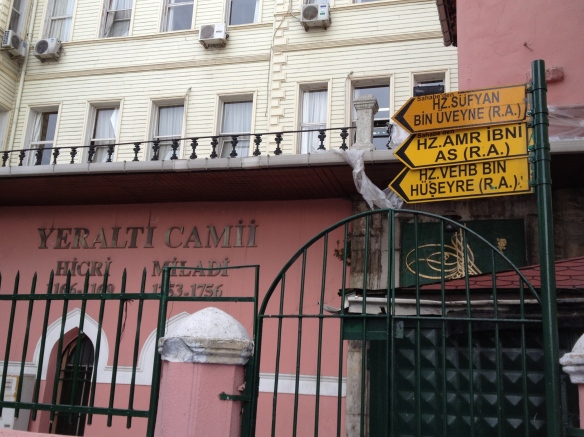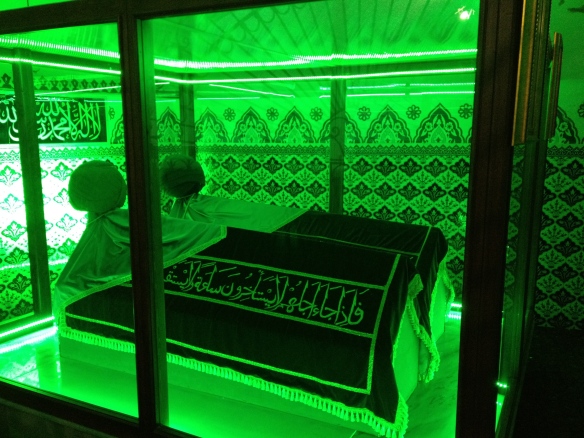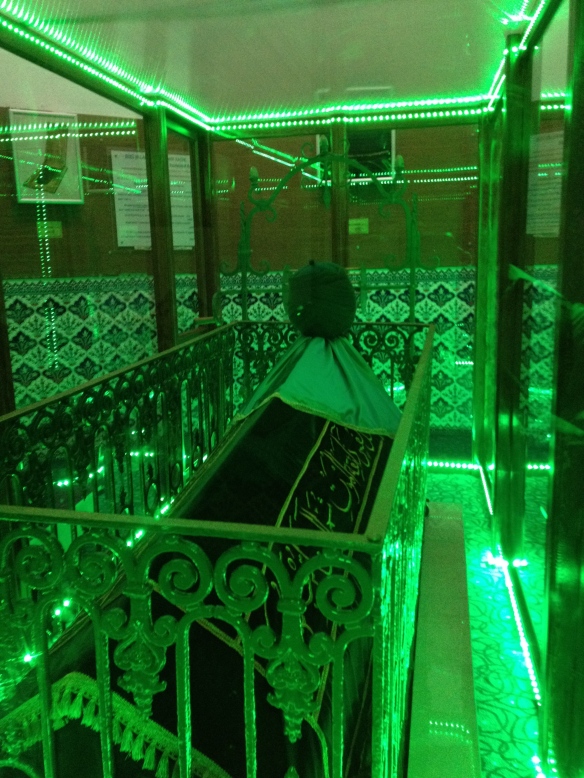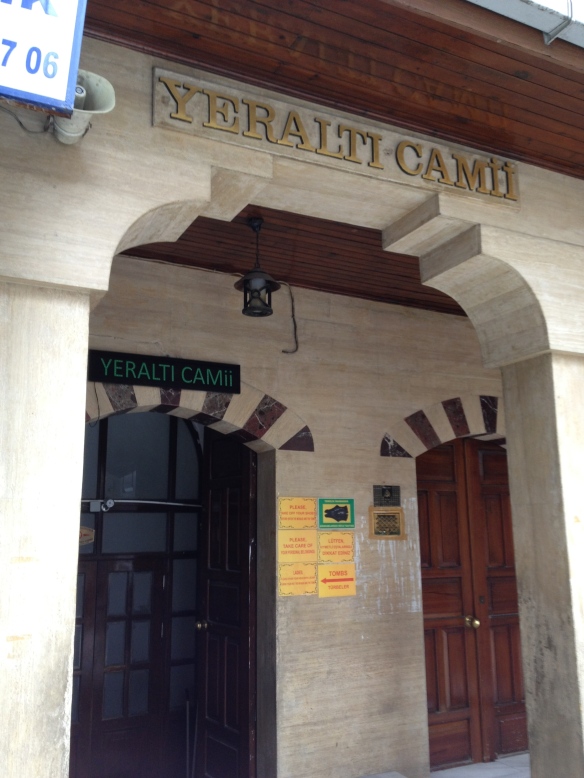For the second post of this series (Part 1) we turn momentarily from Eyüp to cover perhaps the best known tombs after that of Abū Ayyub al-Anṣārī. The site is located in Galata in the Yeraltı Camii or the Underground Mosque, a site previously mentioned in our treatment of Strolling Through Istanbul.
The relevant excerpt from there reads:
Towards the rear of the mosque we find the tombs of two sainted martyrs, Abu Sufyan and Amiri Wahabi, both of whom are supposed to have died in the first Arab siege of the city in the seventh century. Their graves were revealed to a Nakşibendi dervish in a dream in 1640, whereupon Sultan Murat IV constructed a shrine on the site. (Sumner-Boyd and Freely, Strolling Through Istanbul, 412)
There appears to be some confusion as to the names of the persons buried here given that the signs currently posted throughout the Underground Mosque (Amr bin As, Vehb bin Hüşeyre, and Süfyan bin Üyeyne) differ from those given by Sumner-Boyd and Freely. Hasluck, whose work appears in the 1920s, also uses different names in his interesting record:
The building seems to have been identified by the discovery in it of alleged Arab tombs, now attributed to saints named Amiri, Wahabi (left of entrance), and Sufian or Abu Sufian (right of entrance). The latter tomb is the most important of the group and occupies a separate compartment within a grille; it is evidently associated with Sufian, one of the Arab warriors who took part in the first Arab siege (672-7) by Moawiya. It is frequented as a pilgrimage by Turkish and Armenian, occasionally by Greek, women. For a small fee the guardian lays on the tomb a new garment of handkerchief, which, having remained there forty days, is an infallible love-charm, if worn by the man it is desired to attract. Women desirous of children wear round their waists a handkerchief which has been consecrate in a similar way. (Hasluck, Christianity and Islam Under the Sultans, 2:727)
It appears that Sumner-Boyd and Freely relied on Hasluck and confused “Amiri, Wahabi” as a single name when Hasluck rather intended to designate two different ones: Amiri and Wahabi. Furthermore, that one of the tombs might be called Abu Sufyān, rather than just Sufyān, is explained by Hasluck in a footnote which states, “Abu Sufian was the title of the caliph Moawiya.”
Greater detail is given in Namık Erkal’s relatively recent architectural study of the mosque, which was once the Fort of Galata under the Byzantines and then a Leaded Magazine (Kurşulu Mahzen):
In the reign of Mahmud I (r. 1730-1754), it was by the prophecy of a Nakshibendi sheikh from Damascus that the relics of three martyrs from the siege were discovered by the wall of the Magazine in leaded coffins, to further elevate the Islamic connotation of the site -and bring a new reading on the term “leaded”. It was said that the relics were found buried on the side of a wall in a chamber the gate of which was “leaded” by the Umayyads during the siege… There were three coffins within the mosque, one of them being a separate tomb and two others within the Hall behind the rails. (Erkal, “The Corner of the Horn,” 215-6)
The footnote at the end of Erkal’s passage reads:
The relics are said to be of Vehb bin Huseyre (inside the rails, who joined the second Umayyad siege); Amr bin As who is the conqurer of Egypt and who was dead at the time of Umayyad sieges but is believed to visit his tomb within the mosque; Süfyan bin Uyeyne, resting in the Tomb was born in the 8th century and died in 814. The tomb has been constructed and restored several times. (Erkal, “The Corner of the Horn,” 216, fn. 105)
For the sake of this post, I will proceed as if the persons ascribed to the tombs in the Underground Mosque are in fact the ones designated in the presently found signs.
ʿAmr b. al-‘Āṣ (d. 43/663-4) and Wahb b. Hushayra
Near the back entrance of Underground Mosque and off to the side is a gated room bearing two side-by-side tombs bathed in green light. Supposedly therein lie ʿAmr b. al-‘Āṣ (Amr bin As, Turkish) and Wahb b. Husahyra (Vehb bin Hüşeyre, Turkish). ‘Amr b. al-‘Āṣ is best remembered for leading the Muslim conquest of Egypt. As al-Ṭabarī memorializes for “The Events of the Year 43 (April 15, 663 – April 2, 664)”, he also served for the remainder of his life as its governor:
In this year ‘Amr b. al-‘Āṣ died in Egypt on Yawm al-Fiṭr (January 6, 664). He has been its governor for ‘Umar b. al-Khaṭṭāb for four years, and for ‘Uthmān for four years minus two months, and for Mu’āwiyah for two years minus one month. (al-Ṭabarī, History, 18:32)
In his early life, ʿAmr b. al-‘Āṣ was among the Quraysh who opposed the Prophet Muhammad. He was famously sent with ‘Abd Allāh b. Abī Rabī’a to entreat the Negus of Abyssinia to send back the Muslim Emigrants who had fled there. After the Battle of the Trench but before the conquest of Mecca, ʿAmr b. al-‘Āṣ became Muslim. He relates the story of his conversion in Ibn Isḥāq’s biography of the Prophet:
Yazīd b. Abū Ḥabīb from Raṣhid client of Ḥabīb b. Abū Aus al-Thaqafī from Ḥabīb told me that ‘Amr b. al-‘Āṣ told him from his own mouth: When we came away from the trench with the mixed tribes I gathered some of Quraysh together, men who shared my opinion and would listen to me, and said: ‘You know that in my opinion this affair with Muhammad will go to unheard-of lengths and I should like to know what you think of my opinion. I think that we ought to go to the Negus and stay with him. If Muhammad conquers our people we shall be with the Negus and we should prefer to be subject to his authority rather than to Muhammad; on the other hand, if our people get the upper hand they know us and will treat us well.’ They thought that my suggestion was excellent so I told them to collect something that we could take as a present to him; as leather was a product of our land which he most valued we collected a large quantity and took it to him.
While we were with him who should come to him but ‘Amr b. Umayya al-Ḍamrī whom the apostle had sent concerning Ja’far and his companions. He had an audience with the Negus, and when he came out I said to my companions that if I were to go to the Negus and ask him to let me have him, he would give him to me and we could cut off his head; and when I had done that Quraysh would see that I had served them well in killing Muhammad’s messenger. So I went to the Negus and did obeisance as was my wont. He welcomed me as a friend and asked if I had brought anything from our country, and when I told him that I had brought a large quantity of leather and produced it he was greatly pleased and coveted it. Then I said, ‘O King, I have just seen a man leave your presence. He is the messenger of an enemy of ours, so let me have him that I may kill him, for he has killed some of our chiefs and best men.’ He was enraged, and stretching out his hand he gave his nose such a blow that I thought he would have broken it. If the earth had opened I would have gone into it to escape his anger. I said that had I known that my request would have been distasteful to him I would not have made it. He said, ‘Would you ask me to give you the messenger of a man to whom the great Nāmūs comes as he used to come to Moses, so that you might kill him!’ When I asked if he were really that great he said: ‘Woe to you, ‘Amr, obey me and follow him, for by Allah he is right and will triumph over his adversaries as Moses triumphed over Pharaoh and his armies.’ I asked him if he would accept my allegiance to Muhammad in Islam, and he stretched out his hand and I gave my allegiance. When I went out to my companions I had entirely changed my mind, but I concealed my Islam from my companions.
Then I went off making for Muhammad to adopt Islam, and met Khālid b. al-Walīd coming from Mecca. This was a little while before the occupation of Mecca. I said, ‘Where are you going, Abū Sulaymān?’ He said: ‘The way has become clear. The man is certainly a prophet, and by Allah I’m going to be a Muslim. How much longer should I delay?’ I told him that I too was travelling with the same object in view, so we went to Medina to the apostle. Khālid got there first and accepted Islam and gave his allegiance. Then I came up and said, ‘O apostle, I will give you my allegiance on condition that my past faults are forgiven and no mention is made of what has gone before.’ He said, ‘Give allegiance ‘Amr, for Islam does away with all that preceded it, as does the hijra.’ So I gave my allegiance and went away. (Ibn Isḥāq, The Life of Muhammad, 484-5)
As for Wahb b. Hushayra (if the ascribed name is correct) he appears to have been a minor Companion who partook in one of the early Umayyad attacks on Constantinople. As I have fallen short on sources, I would appreciate any references to his life or a reliable identification.
Sufyān b. ‘Uyayna (d. 198/814)
Located in a separate room is a tomb bearing the name of Sufyān b. ‘Uyayna (Süfyan bin Üyeyne, Turkish). It is possible that the tomb has been misidentified since Sufyān b. ‘Uyayna’s years of life puts him later than the generation of the Companions. The actual person buried here may be another (Abū?) Sufyān. Nevertheless, Sufyān b. ‘Uyayna is a revered figure in the Islamic tradition. From Kufa, Sufyān was a noted hadith transmitter, exegete, and jurist. He studied with al-Zuhrī (d. 124/742) and went on to teach al-Shāfi’ī (d. 204/820). Al-Ṭabarī’s biographical entry on Sufyān states:
Sufyān b. ‘Uyayna b. Abī ‘Imrān. His kunyah was Abū Muḥammad; he was a client of the Banū ‘Abdallāh b. Ruwayhbah, [a clan of] the Banū Hilāl b. ‘Āmir b. Ṣa’ṣa’ah. Sufyān’s father, ‘Uyaynah, was a functionary of Khālid b. ‘Abdallāh al-Qasrī. When Khālid was dismissed from [his office as governor of] Iraq and replaced by Yūsuf b. ‘Umar al-Thaqafī, the latter pursued Khālid’s functionaries, so they fled from him. ‘Uyaynah b. Abī ‘Imrān went away and settled in Mecca.
According to Ibn Sa’d > Muḥammad b. ‘Umar [al-Wāqidī]: Sufyān b. ‘Uyaynah told me that he was born in the year 107 [725-6]. He had pursued knowledge at an early [age] and became a ḥāfiẓ. He lived a long life, until his peers died and he outlived them.
Sufyān related: I went to the Yemen in the years 150 [767-8] and 152 [769-70] while Ma’mar [b. Rāshid] was still alive. [Sufyān] al-Thawrī preceded me [there] by a year.
According to Ibn Sa’d > al-Ḥasan b. ‘Imrān b. ‘Uyaynah, Sufyān’s nephew: I was with my uncle on the last pilgrimage he made [to Mecca], in the year 197 [August 813]. When he was at Jam’, having prayed, he lay on his mat and said to me: “I have arrived at this place for seventy years, and each time I said ‘O Lord, do not make this the last time that I visit this place.’ I feel embarrassed before God about asking Him this so many times.” Sufyān returned [from his pilgrimage] and died the next year, on Saturday the 1st of Rajab 198/February 25, 814. He was buried at al-Ḥajūn. He was ninety-one years old [when he died]. (al-Ṭabarī, History, 39:265-6)
Erkal, Namık. “The Corner of the Horn: An Architectural Review of the Leaded Magazine in Galata İstanbul.” Middle East Technical University (METU) Journal of the Faculty of Architecture 28.1 (2011): 197-227.
Hasluck, F.W. Christianity and Islam Under the Sultans, Volume I and II. Oxford: Clarendon Press, 1929.
Muḥammad b. Isḥāq b. Yasār. The Life of Muhammad: A Translation of Isḥāq’s Sīrat Rasūl Allāh. Translated by A. Guillaume. Oxford: Oxford University Press, 2004.
Sumner-Boyd, Hilary and John Freely. Strolling Through Istanbul: The Classic Guide to the City. London: Tauris Parke Paperbacks, 2010.
al-Ṭabarī, Muḥammad b. Jarīr. The History of al-Ṭabarī, Volume XVIII: Between Civil Wars: The Caliphate of Mu’āwiyah. Translated by Michael G. Morony. Albany: State University of New York Press, 1987.
al-Ṭabarī, Muḥammad b. Jarīr. The History of al-Ṭabarī, Volume XXXIX: Biographies of the Prophet’s Companions and Their Successors. Translated by Ella Landau-Tasseron. Albany: State University of New York Press, 1998.
To access the other posts in the series:
The Sahaba of Istanbul [1] Abu Ayyub al-Ansari
The Sahaba of Istanbul [3] Eyup
The Sahaba of Istanbul [4] The City Walls of Leo and Heraclius
The Sahaba of Istanbul [5] The Ayvansaray Coast
The Sahaba of Istanbul [6] Galata/Eminonu/Sultanahmet (forthcoming)





